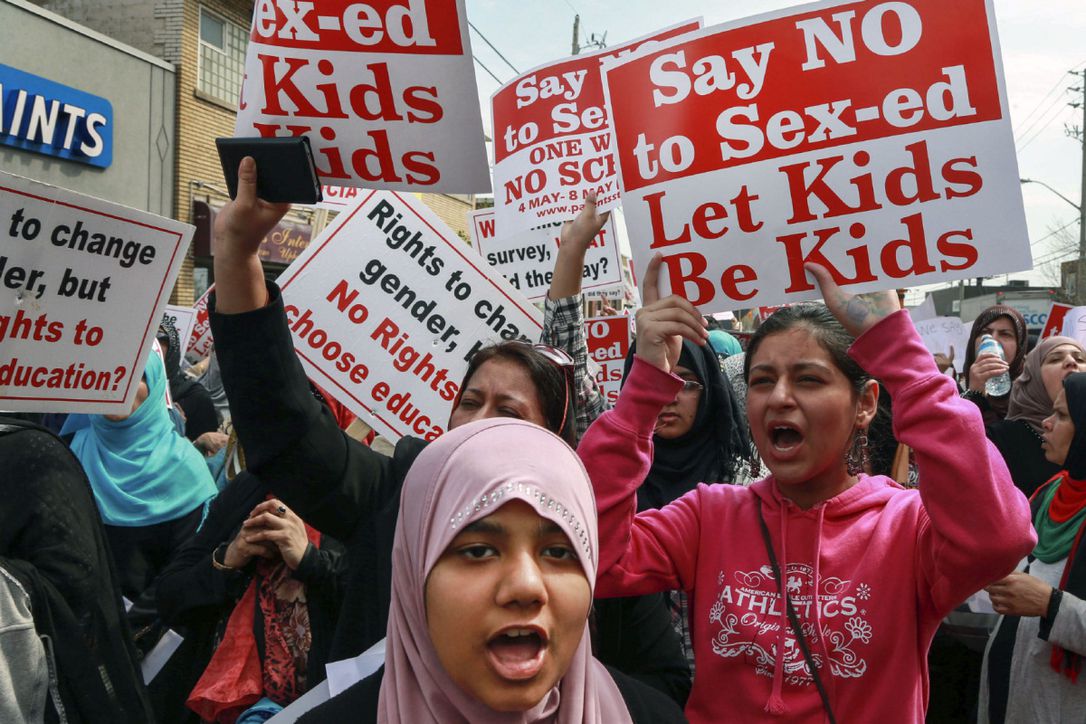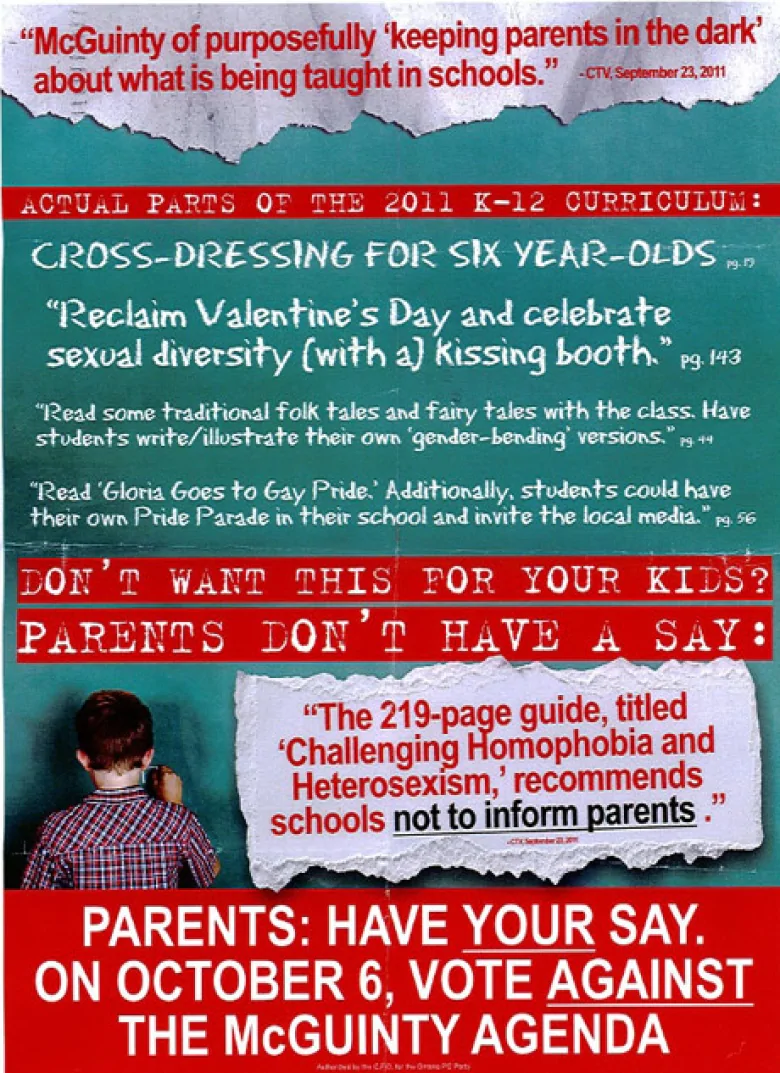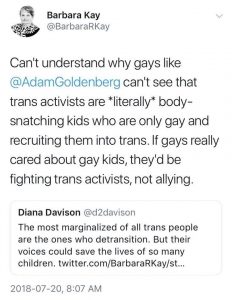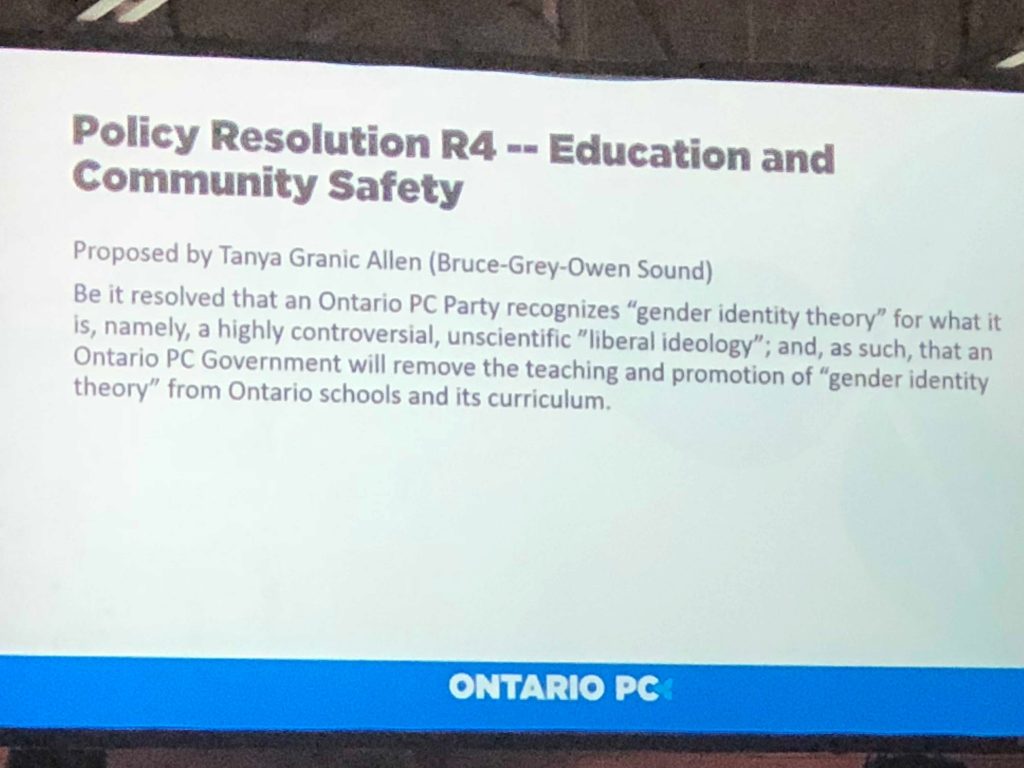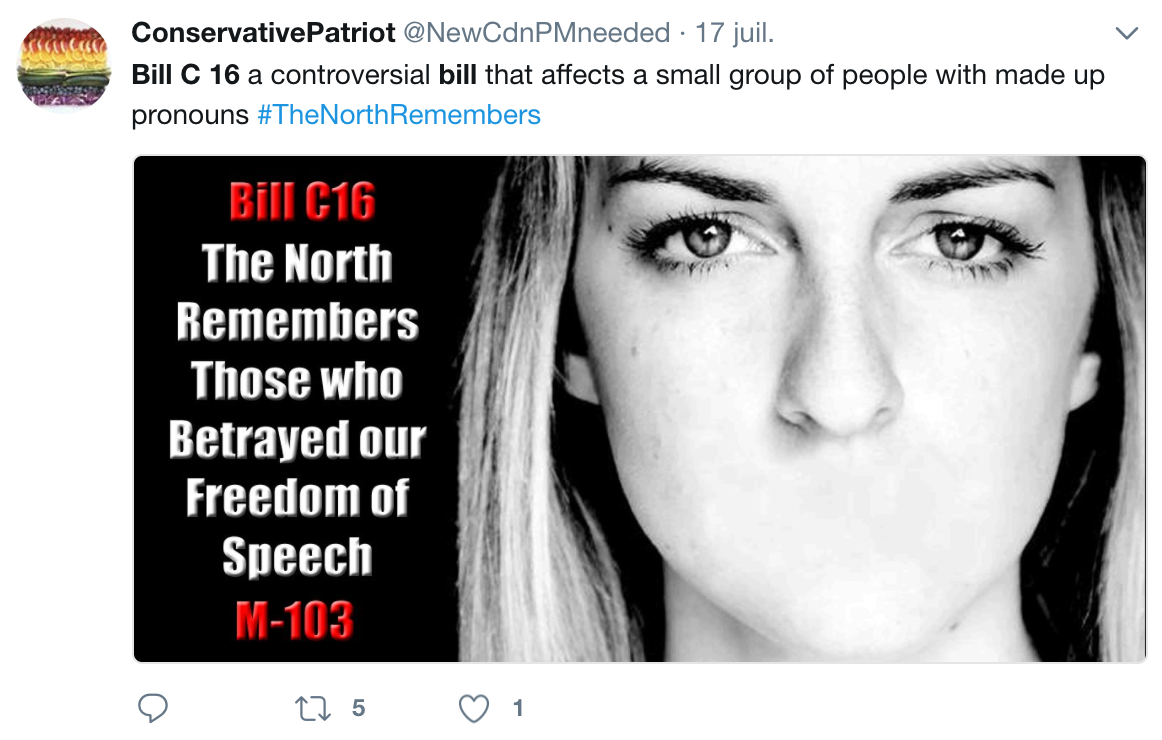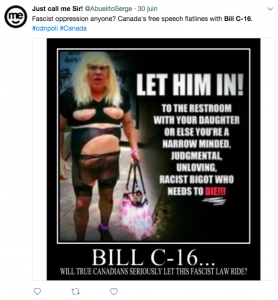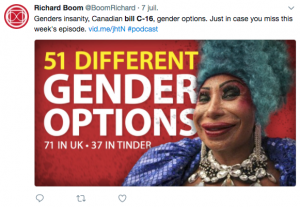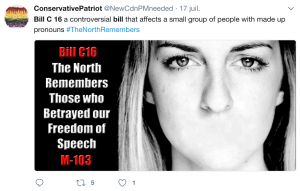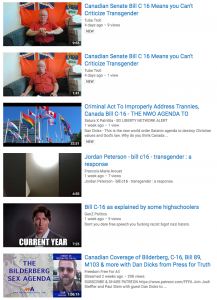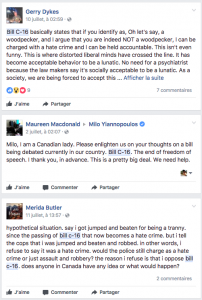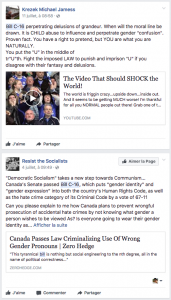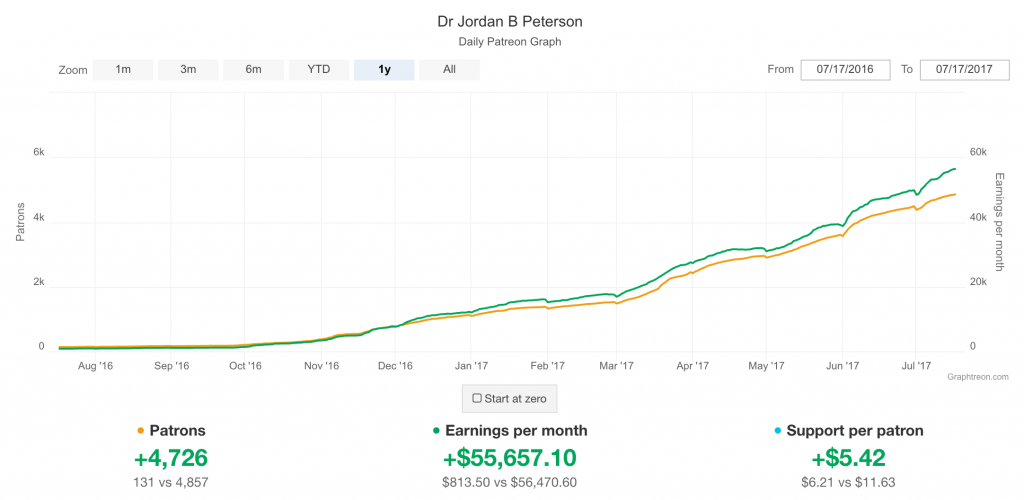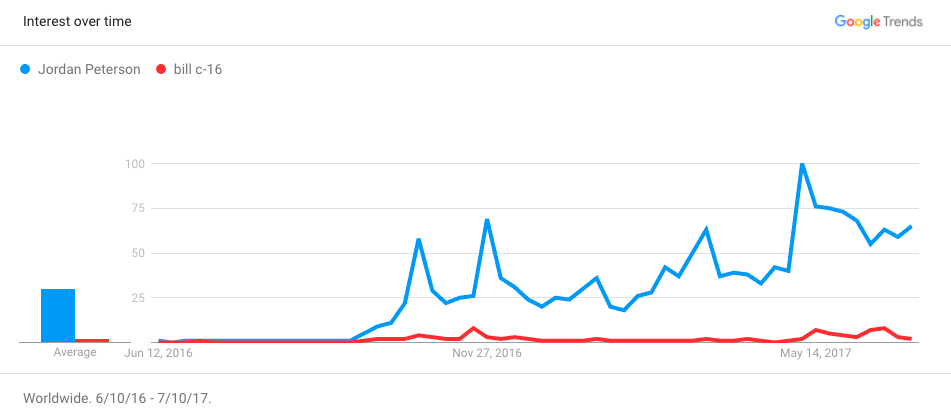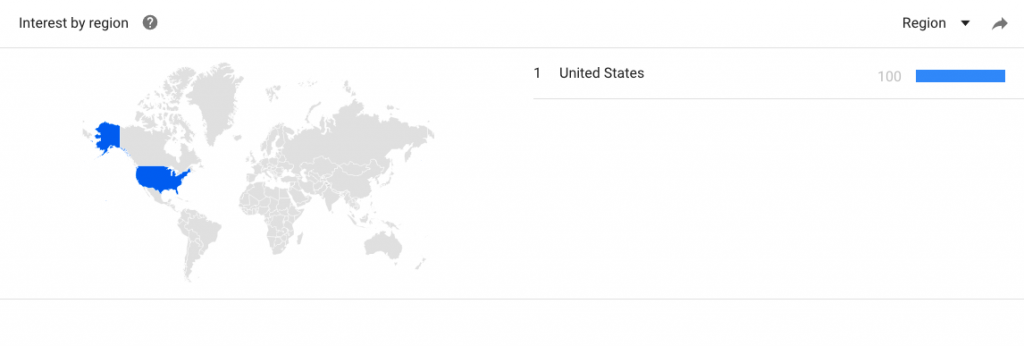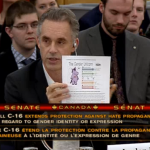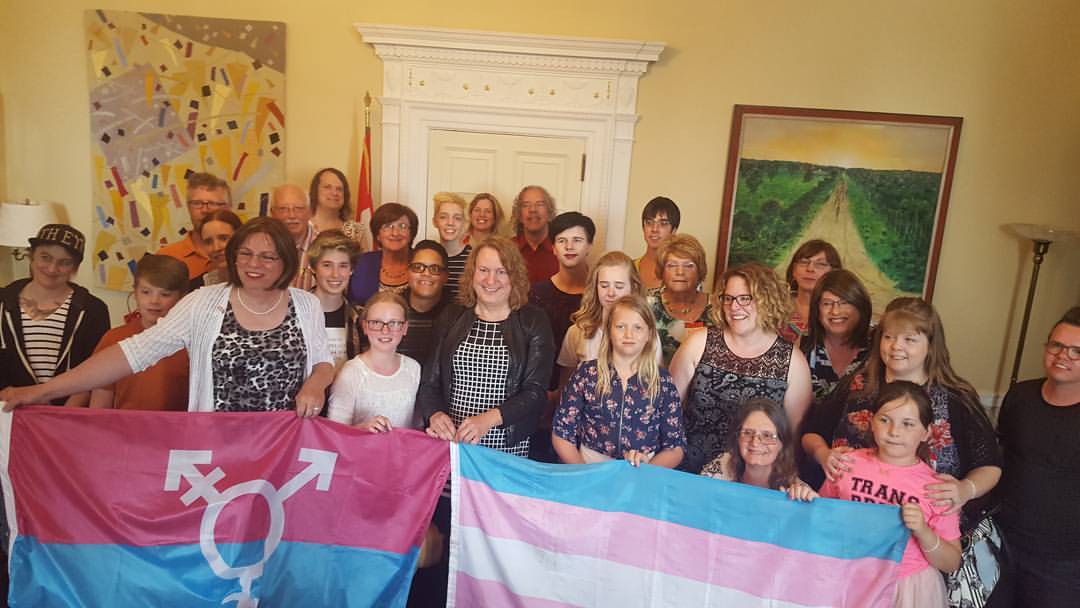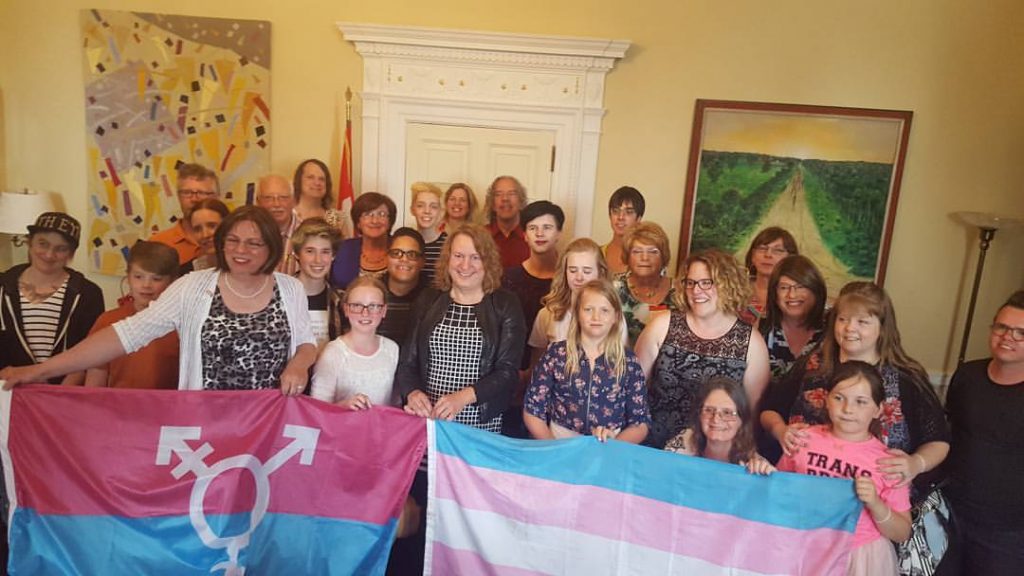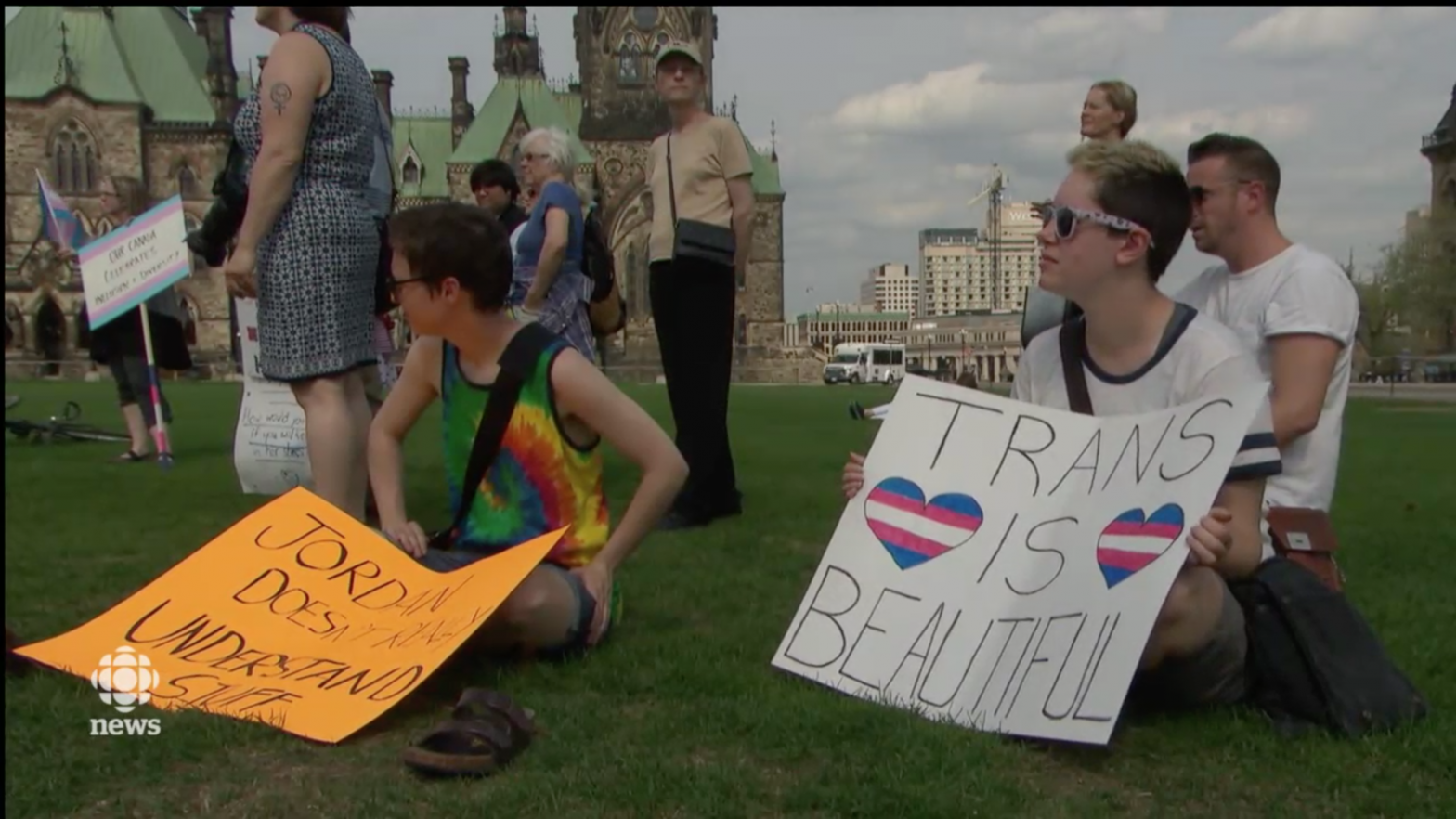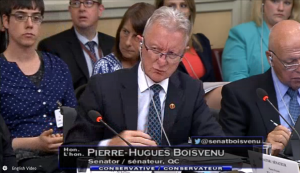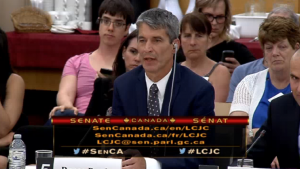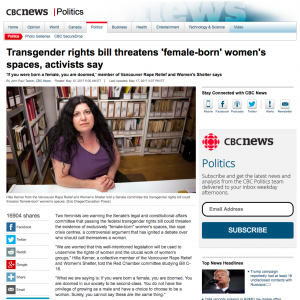The National Post is one of two leading national newspapers in Canada. From 2011 to 2018, the National Post has released at least sixty editorials advocating against the acceptance of trans people. Most of these date from after 2014.
So I thought I would paint a picture of trans people, as depicted by the National Post. I’m doing so without commentary as I believe it’s more revealing this way.
Trans women are not women
From Diluting the meaning of ‘woman,’ to appease transgender activists, is misogyny (Original title: Transwomen deserve respect. But they aren’t ‘women’):
Radical transactivists are guilty of the worst form of misogyny in their ruthless campaign to erase from our thoughts the human female body as a unique life form.
Such an absurdity — a woman literally redefined as a man or a woman — could be sloughed off as an over-reach if politicians, the justice system and school boards were not similarly complicit in enforcing compliance with this lie.
Whatever is going on in his mind and heart, a biological male “is” not a female. Two plus two “is” still four.
From Transgendered advocacy has gone too far:
True sex change … is simply not possible; you end up as a “feminized man” or a “masculinized woman.”
From Sorry LGBT, sex and gender are not the same:
Psychologically trapped or not, the body remains one sex or the other until the genitalia are surgically altered.
From Is noted feminist Germaine Greer a hateful anti-transgender misogynist?:
“Just because you lop off your dick and then wear a dress doesn’t make you a f***ing woman,” [Germaine Greer] said.
However, to be a woman involves a set of biological and social rites that someone who merely looks like a woman can never fully appreciate.
She objects to transgender men appropriating her gender and flaunting a surgically enhanced caricature of it. They are engaging in a fantasy of womanhood free of its dangers and pitfalls.
From Disqualifying a transgender person from a female beauty contest isn’t discrimination:
Ms. Talackova began hormone therapy as a teenager and underwent a sex reassignment surgery two years ago.
Even if Ms. Talackova may have always felt she was a woman, the fact is that she wasn’t.
From Jenna Talackova goes double dipping in the theatre of gender politics:
Ms Talackova, you will recall, is the surgically transgendered woman who successfully challenged the rules of the Miss Universe Canada contest when she was rejected according to the rules disallowing transsexuals.
I should think that amongst the diminishing coterie of non-ideologues for whom beauty contests still hold significance, Ms Talackova’s presence was a joke. A joke, mind you, they have been well trained in political correctness enough to understand they mustn’t laugh out loud at, but a joke nonetheless.
From One gay man’s lonely fight against Ontario’s new law banning ‘mother’ and ‘father’:
Mocking the transgender argument that people are whatever gender they feel they are — male, female, something in between, or none of the above — Clark refuses to concede longstanding facts of life: “Men don’t have vaginas or female anatomy … and women don’t have penises,” he says.
From Between two sexes:
…any attempt by one sex to pass as the other is an impossibility, since males and females are different…
From This is what Bruce Jenner thought women were?:
I finally figured it out: the Vanity Fair cover of Caitlyn Jenner represents none of what matters about women, and lots of what harms us. That a man — athletic, accomplished, successful — can, in 2015, announce to the world: “I’ve decided to become a woman,” and then go on to proudly present herself as a corseted, puffed-and-buffed bimbo whose only credentials as a woman are breasts and professional makeup. What’s worse: people are taking it seriously.
From Caitlyn Jenner trivializes the momentousness of what it means to be a woman:
As Mark Steyn puts it in a deeply insightful column analyzing the new tyranny of trans correctness, Caitlyn is neither man nor woman – “she’s a transwoman – a new, separate … category…
By her family, Caitlyn is a woman, and by her 10 million Twitter followers, Caitlyn is a woman… But by doctrinaire feminists – and I never thought I would say this, but they seem to me, in terms of ideological integrity, to be the brave ones in this affair – she’s not a woman.
From Caitlyn Jenner, Rachel Dolezal and the identity double standard:
And it’s instructive to contrast Dolezal’s fate for saying she feels black with that of Bruce Jenner for saying he feels like a woman.
It perfectly captures the modern spirit of narcissistic relativism. And once you abolish truth you never find a stopping place. Social change is a process not a destination. But once “Caitlyn” Jenner has been lionessized on the cover of Vanity Fair, what frontiers remain?
And if you can change your sex just by saying “Ecce femina” why not your race while you’re at it? And your height.
From Hillary’s hypocrisy:
It’s an odd world. Glamour magazine recently named the former Bruce Jenner as its Woman of the Year. … In this context, coming out is simply to be understood as an act of self-declaration. If a person self-identifies as X, Y or Z, then he, she, ze or hir has to be what he, she, ze or hir professes to be. If it’s a nightmare for grammarians, just think of the chaos in biology departments.
“I’ve asked my doctor to give me long ears and liver spots and I’m going to wear a brown coat but that won’t turn me into a fucking cocker spaniel,” [Germaine Greer] said.
From Delaware students can now choose their own race. This should end well:
I have a chicken-and-egg theory about the whole trans phenomenon we are witnessing. It only took off in a big way when the chemical means became available to artificially mimic the opposite sex in self-presentation. In other words, the notion that one was born in the wrong body only became a social contagion when the look of the assumed identity could be approximated via medication.
From Sex and the troubled mind (Original title: Gender issues are a matter of sex and the troubled mind):
It has become politically incorrect to suggest that transgenderism or transsexualism is anything more than an alternate lifestyle … In the new parlance, “normal” is not how people are born biologically, it is whatever they think they are.
…we should lend our efforts to research that will lead to a cure for this terribly sad psychological problem.
From Conservatives may win elections. But liberals have been winning the culture:
But, barely pausing to celebrate their victory on gay marriage, the identity-group enforcers have gone full steam ahead on transgender issues.
Having done an impressive job of demolishing the basic societal building block of the family, the ambitious liberal is now moving on to demolishing the basic biological building block of the sexes.
Parents should not accept their trans child
From B.C. school official protests ‘transgender education’ — and pays the price:
Letting little children choose to change gender is nothing short of child abuse
From Between two sexes:
Biological homelessness — “gender identity disorder” in the jargon — is a very real, biologically rooted condition, but it is nothing to celebrate or encourage.
Yet the message we are getting from academics and pedagogues fixated on gender equality is that biological ambiguity should be valorized and even encouraged, at any rate certainly not discouraged.
From Stop being a jerk over someone’s pronoun preference — they’re human beings, not issues:
“Let’s say it were possible to take a 10-year-old kid and make them either a well-adjusted lesbian or turn them into a female-to-male transsexual,” Blanchard told Rogan. “I don’t see anything wrong with saying it’s better to make this kid into a lesbian, because being a lesbian doesn’t require breast amputation, the construction of a not-very-convincing false penis, and a lifetime of testosterone shots.”
A trans child coming out is cause for parents not to accept them (and parents are the victims here)
From Parents face scorn for worrying about letting their children change genders (Original title: Parents victimized in the identity vs mental health battle over transgendered children):
“Out of the blue,” never having shown signs of gender dysphoria before puberty, a girl announces she is trans.
Many parents, influenced by a bullishly trans-supportive cultural environment … offer uncritical support for transitioning. By contrast, the skeptical parents think medicalization is too drastic for what could be a transient phase, and resist. What happens to them isn’t pretty.
From A new report sounds the alarm on Rapid Onset Gender Dysphoria:
Imagine yourself the parent of an adolescent boy or (more likely) girl without a single previous sign of body dysphoria, who “out of the blue” decides she is transgender.
Parents often felt betrayed by the unprofessional attitudes of clinicians they consulted: psychologists, pediatricians, gender therapists and endocrinologists. Many were resistant to exploring other sources of distress, or hostile to parental testimony regarding their children’s fabrications.
From How trans activists are unethically influencing autistic children to change genders:
Their parents felt confused at what appeared to them to be a sudden change in their daughters.
Their experiences align with accounts by parents of “trans” kids on the blog, 4thwavenow.com, described as “a community of parents and friends skeptical of the ‘transgender/child/teen’ trend.”
Tumblr is to blame for this trans thing
From Parents face scorn for worrying about letting their children change genders (Original title: Parents victimized in the identity vs mental health battle over transgendered children):
Mothers I’ve spoken to referred to Tumblr and DeviantArt as prime influences.
From A new report sounds the alarm on Rapid Onset Gender Dysphoria:
Almost invariably, these teenagers spend an inordinate amount of time on certain websites, notably Tumblr and Reddit. Here they can find advice on how to lie to clinicians: “Get a story ready in your head … keep the lie to a minimum” and “look up the DSM for the diagnostic criteria for transgender and make sure your story fits it.”
She found reviewing Reddit, SubReddit and Tumblr comments very troubling. Disparagement of heterosexuals and “cisgenders” is rife. Contempt for parents is encouraged. Feelings of victimhood are promoted.
This trans thing is a social contagion
From Delaware students can now choose their own race. This should end well:
I have a chicken-and-egg theory about the whole trans phenomenon we are witnessing. It only took off in a big way when the chemical means became available to artificially mimic the opposite sex in self-presentation. In other words, the notion that one was born in the wrong body only became a social contagion when the look of the assumed identity could be approximated via medication.
From Parents face scorn for worrying about letting their children change genders (Original title: Parents victimized in the identity vs mental health battle over transgendered children):
Linda had resisted affirming her daughter’s decision to transition because of its suddenness, and because the daughter had a history of other psychological issues. She voiced her concerns to the group, expressing her opinion that [Rapid Onset Gender Dysphoria] was a “social contagion” rather than a true identity. Linda said she would not support medical intervention.
From A new report sounds the alarm on Rapid Onset Gender Dysphoria:
One reinforces the theory that [Rapid Onset Gender Dysphoria] can be a form of “social contagion.” (In one case study, a 14-year-old natal female and three of her natal female friends announced they were transgender within a year of a popular coach’s announcement that she was transgender.)
Trans people are exploiting children (with sex education)
From How trans activists are unethically influencing autistic children to change genders:
The trans movement is crossing ethical lines with a vulnerable subset of youth struggling with issues of gender identity.
A recent article by Elise Ehrhard in Crisis Magazine, a Catholic periodical, addresses the aggressive approach by adult trans activists in recruiting adolescents with Asperger’s Syndrome or other types of Autism Spectrum Disorder (ASD) to their cause.
From Between two sexes:
Sex merging is especially present in domains where pre-sexual children are ripe for indoctrination.
At the gender-neutral Egalia pre-school in Stockholm, staff avoid using words like “him” or “her” and address the 33 kids as “friends” rather than girls and boys.
Ideologues applaud these bizarre initiatives, but I don’t know any ordinary person, including myself, who is not appalled by this absurd and dangerous impulse toward social engineering.
From B.C. school official protests ‘transgender education’ — and pays the price:
SOGI 123 [curriculum supplement on sexual orientation and gender identity] represents a sectarian belief system, whose advocates seek normalization of the statistically rare phenomenon of irreversible gender dysphoria through an unproven concept — despite the assertions of transactivist militants, there is no scientific evidence to suggest that biology and gender are unlinked — that can cause psychological harm to children.
I predict a surge toward home-schooling by parents who refuse to allow their children’s minds to be exploited as pedagogical guinea pigs.
From Vancouver school board gender policy allows “xe” or “xem” in place of “he” or “her”:
B.C., it is clear, does not view schools as a place in which children are taught the basic tools necessary to navigate life – math, science, geography – but as petri dishes for social experimentation in which teachers are lab technicians with unwitting children as their mice.
On Monday, the Vancouver School Board approved a policy change aimed at accommodating gender identity and sexual orientation. … Parents who questioned the change argued, quite reasonably, that six-year-olds aren’t qualified to understand all the intricacies of identity issues.
From Shutting our minds to the truth:
This is abundantly clear in the third grade of the Ontario sex-ed curriculum, where children are introduced to the thought-experiment that their gender identity may be at odds with their biological sex. They can be a male trapped in a female body, and vice versa.
The moral and psychological and health implications of this experimental teaching alone would be worthy of a parental revolt. The suicide rates for trans people rises above 40 per cent.
Yet even purely intellectually speaking, the public education establishment is involved in disseminating what can only be termed propaganda.
From Suggestions for the new Ontario sex-ed curriculum:
Much of what children are learning about transgenderism today, at a very tender age, is not science-based, but activist-dictated theory that can result in psychological harm.

Trans people are worse-off for transitioning
From Parents face scorn for worrying about letting their children change genders (Original title: Parents victimized in the identity vs mental health battle over transgendered children):
…the assumption that a gender transition will solve their problems is unrealistic and potentially tragic, as elevated post-transition suicide attempt rates demonstrate.
Meanwhile, they’ve observed “the mental health and social relationships of children with [Rapid Onset Gender Dysphoria] get much worse once they adopt transgender identities,”
From Transgendered advocacy has gone too far:
And they are correct, as many apparently transgender children accept their biological identity at puberty, and many adults express regret over their surgeries.
Of the 324 surgical patients studied, the suicide rate was 20 times the non-transgender population.
From Bill 77, the Affirming Sexual Orientation and Gender Identity Act, is a dangerous overreach:
A 2011 long term Swedish study that followed a 30-year trajectory of 324 people who had sex reassignment surgery found that suicide rates 10 years after surgery were 20 times that of the non-trans population.
Surely it is the government’s first responsibility to try to prevent suicides rather than to validate emotive claims made by those least capable of assessing their condition with objectivity.
Trans women should be prohibited from women’s washrooms
From Diluting the meaning of ‘woman,’ to appease transgender activists, is misogyny (Original title: Transwomen deserve respect. But they aren’t ‘women’):
Transactivists bristle at the very idea that girls and women may be at risk in single-sex environments when biological males have access to them.
A Sept. 2 article in The Sunday Times states the newspaper’s own investigation showed that “(a)lmost 90 per cent of reported sexual assaults, harassment and voyeurism in swimming pool and sports-changing rooms happen in unisex facilities, which make up less than half the total.”
From Can Catholic teachings on sexuality be reconciled with mainstream values?:
On a practical level, there may well be concerns with allowing biologically male or female children to use a communal bathroom belonging to the opposite sex, and the NDP should respect a school’s discretion on this point.
From The left is now so arrogant it doesn’t even see the need to cover up its petty retributions:
So the apparent message is that if you want to have a career, even start one, stay away from anyone espousing what have very suddenly become intolerable views on gender like that men shouldn’t pee in the girls’ bathroom.
From There’s no safe space on campus to debate bathroom politics:
But Trent has instituted a policy of gender-neutral washrooms, and Brown balks at sharing intimate space with members of the biologically opposite sex. She discovered that expression of her discomfort is more than unwelcome on her campus; it has literally become a forbidden opinion.
To conclude on a personal note, from what I understand of Transparent’s Maura, she would have been perfectly happy to pee in a designated single-stall bathroom, physical relief, not tyranny over others, being her objective.
Trans people are ruining sports
From Hockey dressing rooms should belong to players and coaches, not human rights commissions:
Because of a settlement reached four years ago in a case brought to the Ontario Human Rights Commission in 2013, the Ontario Hockey Federation, the governing body for most of minor hockey in the province, has now trained its coaches in gender diversity…
If only Jesse Thompson … wouldn’t have needed to file a human rights complaint — and now, there wouldn’t be a whole new set of rules and regs tailored to 0.7 per cent of the population with issues that were only ever a problem for 0.7% of the hockey population.
From Pronouns are ruining the best thing about hockey:
I think a mandatory pronoun check-in is regrettable because of the emphasis on difference as opposed to an emphasis on oneness — that we are all the same.
From Is noted feminist Germaine Greer a hateful anti-transgender misogynist?:
Greer was expressing a not-unreasonable concern that a transgender athlete would enjoy an unfair biological advantage over her female counterparts.
From Why the world may end with a bang — and sooner than you think:
Then transgender rights came along and within a couple of years we had people born male racing in women’s track events and heading feminist organizations, and academic censorship of opposing views. Can it really keep going like this?
It’s okay to disclose the genitals of trans people to an international audience without their consent
From Caitlyn Jenner, Rachel Dolezal and the identity double standard:
But you could cast as much doubt on Jenner’s claim to be female. She has, after all, got a penis.
From Women’s prison left to cope after getting male inmate who identifies as female:
Yet Bellmore, who still has the requisite male gear, is in a so-called “living unit” with as many as 11 other women.
From We’re supposed to send people, not penises, to prison:
Since Edison identifies as a woman but has not had gender reassignment surgery, Canadian law says she must be held in a men’s institution.
From Disqualifying a transgender person from a female beauty contest isn’t discrimination:
Ms. Talackova began hormone therapy as a teenager and underwent a sex reassignment surgery two years ago.
From Caitlyn Jenner trivializes the momentousness of what it means to be a woman:
Compare her to a partially transitioned woman-to-man of 65 who, though everyone is aware he has no penis, dresses up as a Navy Seal in camouflage…
They/them pronouns are too hard or at least part of a conspiracy
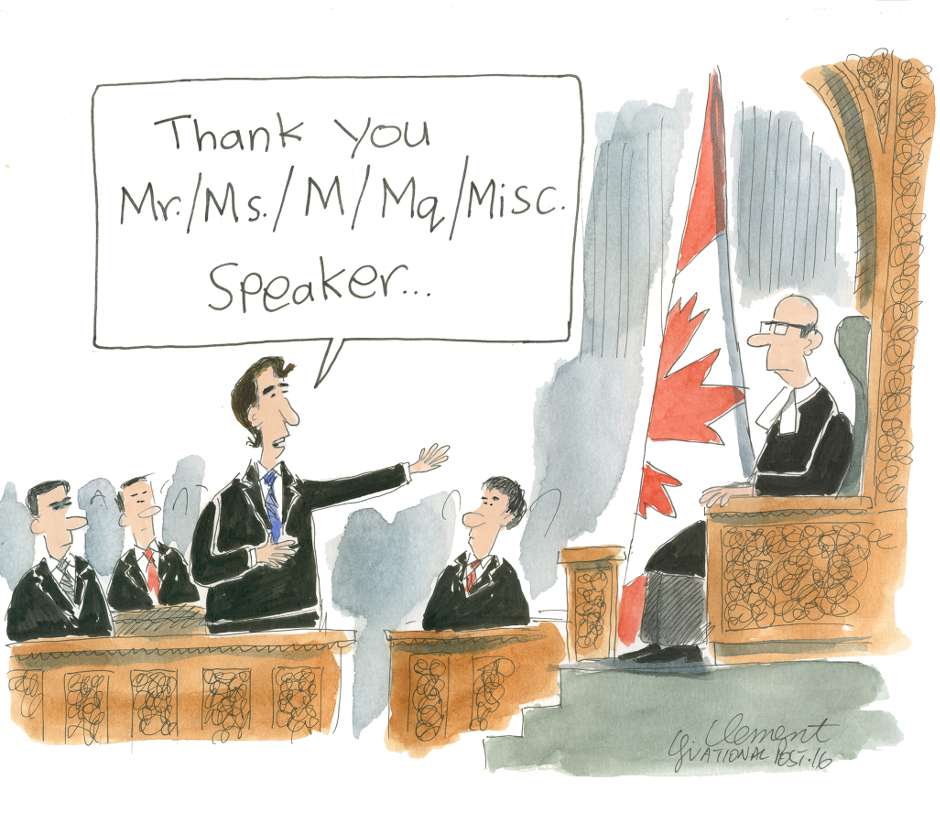
From The confusion of raising genderless children and the time I was ‘Jack’:
I can’t even get my head around what it must be like trying to determine what “they” want for dinner; it must be like an endless game of who’s-on-first.
I find it precious to be asked to call a single human being by a plural pronoun, I would, if asked. (I wouldn’t write it that way, however, because it just gets stupid. See what-do-you-want-for-dinner, above.)
From The right to be politically incorrect:
I would not use what have come to be known as “preferred pronouns” to refer to people who believe that their gender does not fit neatly into the traditional categories of male and female.
I will never use words I hate, like the trendy and artificially constructed words “zhe” and “zher.” These words are at the vanguard of a post-modern, radical leftist ideology that I detest, and which is, in my professional opinion, frighteningly similar to the Marxist doctrines that killed at least 100 million people in the 20th century.
Finally, it is absurd to insist that each person should have the right to, or could practically, choose their own pronouns.
From Prof. Peterson must not face this assault on reason and his rights alone:
I have and continue to urge against and dismiss as absurd and outrageous the demand that those who purport to be in a transgender condition that is neither male nor female, have a right to be addressed in a new vocabulary of their devising.
From If gender identity debate at U of T was about free speech, then the battle is truly lost:
Bryson’s official profile on the UBC site uses the pronoun “they” to refer to her, as in, “Throughout Mary’s 27 years at UBC, they have served in many senior administrative roles…” I take from this that “they” is her preferred pronoun, but I decline to use it.
From Jordan Peterson speaks for those of us that refuse to follow the ‘great liberal death wish’:
“Ze” for he or she and “Zir” in place of his or him are the sticking points, but what is accumulating behind these imbecilic distinctions is quite sinister.
But no individual or group has the right to invent a new vocabulary and a new co-equal gender because of a state of ambivalence or confusion about which sex they are.
From Meet the new ‘human rights’ — where you are forced by law to use ‘reasonable’ pronouns:
On Thursday, the Senate passed Bill C-16, the Liberal government’s legislation that adds “gender identity or expression” to grounds of discrimination in the Canadian Human Rights Act.
Few Canadians realize how seriously these statutes infringe upon freedom of speech.
In other words, failure to use a person’s pronoun of choice — “ze,” “zir,” “they” or any one of a multitude of other potential non-words — will land you in hot water with the commission. That, in turn, can lead to orders for correction, apology, Soviet-like “re-education,” fines and, in cases of continued non-compliance, incarceration for contempt of court.
From When the government tells us how to speak:
Prof. Peterson is facing intense criticism from students, professors and administrators for saying he will not use genderless pronouns (such as “they”) to refer to transgender students, if asked.
Forcing members of private organizations to call transgender people by the personal pronouns of their choosing is a form of conscripted speech.
From Are zee ready for the dictatorship of the gender warriors?:
The aim of the exercise is to remove any hint of gender from the language. It’s the goal of people who feel that being identified as male or female is a trap, or a prison, and wish to break free. They do not “identify” as either of the conventional genders, and feel their perspective should be recognized and respected by others, and that the language should be adapted to suit their needs.
If the language can be bent to suit every individual preference, it ceases to have rules and becomes yet another victim of political purity, as dictated by whatever identity group has the megaphone today.
From Our campuses show we’re practicing cultural genocide on ourselves:
The cowardice of the regime limped to the aid of the winner of the media and public relations contest, as the University of Toronto did last year when transgender groups tried to force Peterson to address them in a special vocabulary, the words “he, she, and you” being somehow disrespectful.
From Jordan Peterson — a real professor, at last:
The older, raw, honest tyrannies told people what not to speak. But the new, wilier versions, midwifed by our famous human rights overseers, are proposing to insist on what we must speak. Here be the new axioms of our day: we own your pronouns, use no others. “He” and “she” are assault words. Freedom of speech is the life-raft flotsam of gurgling obscurantists and bigots going down for the last time.
From Embattled U of T professor a warrior for common sense and plain speech:
He’s a hurricane of fresh air, this university professor who baldly says that one of the many reasons he won’t adopt the faddish new non-binary gender pronouns is that “the people who made those words are possessed by ideology and not to be trusted anyway.”
From Jordan Peterson vs. the new freedom fighters at Queen’s University:
In other words, if I, as a short, old, straight, white woman demand to be called “they” or “him” or “the king of England,” I must be accommodated.
From M-103 is a political billboard. Pick a side and advertise your virtues:
The recent controversy over Professor Jordan Peterson’s refusal to mouth the latest neologisms for transgenders — the “xe, xir, xem” and the like — earned for him accusations of being “transphobic.” I think any fair reading of Peterson’s arguments utterly deflate that accusation.
From The prime moment Jordan Peterson’s ‘gotcha’ was heard around the world:
The case of the professor who refused to speak made-up pronouns…
From In 12 years, free speech on our campuses has gone from routine to besieged:
Accentuating the differences of a group already afflicted by feelings of being outcast, through inventing and mandating the use of discriminative gender identifiers, will only exacerbate feelings of ostracism.
From Yes, the ‘gender unicorn’ is absurd, but something even wackier will follow:
That toolkit, by the way, also suggests that teachers address students in gender-neutral terms such as friends, folks or “comrades.”
True stuff, as Peterson might say, and beyond absurd.
Using trans people’s pronouns is comparable to Hitler, Mao, 1984 and genocide
From When the government tells us how to speak:
In the later years of Adolf Hitler’s Germany, the government made it compulsory for people to use the “Heil Hitler” salute in all public greetings. They risked prosecution, arrest and even death for refusing to do so.
Prof. Peterson is facing intense criticism from students, professors and administrators for saying he will not use genderless pronouns (such as “they”) to refer to transgender students, if asked.
Forcing members of private organizations to call transgender people by the personal pronouns of their choosing is a form of conscripted speech.
From The right to be politically incorrect:
I will never use words I hate, like the trendy and artificially constructed words “zhe” and “zher.” These words are at the vanguard of a post-modern, radical leftist ideology that I detest, and which is, in my professional opinion, frighteningly similar to the Marxist doctrines that killed at least 100 million people in the 20th century.
Bill C-16 [adds “gender identity or expression” to grounds of discrimination in the Canadian Human Rights Act] is dangerous legislation. Those who formulated it and who are pushing it and its sister legislation are dangerous people.
From Diluting the meaning of ‘woman,’ to appease transgender activists, is misogyny (Original title: Transwomen deserve respect. But they aren’t ‘women’):
In his writings on totalitarianism, George Orwell powerfully exposed the link between the manipulation of language and the erosion of individual liberty. Ideologues understand that linguistic control precedes, and is crucial to, political and cultural power. The novel 1984 illuminated the shame in being compelled — figuratively — to endorse the lie that two plus two is five.
Categorization is the basis of knowledge. Whatever is going on in his mind and heart, a biological male “is” not a female. Two plus two “is” still four.
From Our campuses show we’re practicing cultural genocide on ourselves:
Shepherd had created a “toxic climate” and an “unsafe learning environment,” and had violated the university’s “gender and violence policy,” and had incited “gender-based transphobia” by presenting, with contrary argument, the views of Peterson.
The inquisitors falsely described Peterson as a “white supremacist” who “targeted and harassed” transgender students and incited “transphobia” in a manner that is illegal under human rights legislation.
The cowardice of the regime limped to the aid of the winner of the media and public relations contest, as the University of Toronto did last year when transgender groups tried to force Peterson to address them in a special vocabulary, the words “he, she, and you” being somehow disrespectful.
From Trudeau’s love of dictatorships is showing again at home:
It’s a harsh word, but “totalitarian” is the mot juste to describe governments that use their power — and public resources — to enforce ideological agreement with the maximum leader. That is exactly what the federal Liberals are doing in imposing an ideological test and coerced speech upon the Canada Summer Jobs Program.
But now, in order to qualify, the federal department of employment demands that the “organization’s core mandate respect … the right to access safe and legal abortions … and the rights of gender-diverse and transgender Canadians.” If you refuse the loyalty oath to Liberal party policy, you can’t apply.
From Meet the new ‘human rights’ — where you are forced by law to use ‘reasonable’ pronouns:
On Thursday, the Senate passed Bill C-16, the Liberal government’s legislation that adds “gender identity or expression” to grounds of discrimination in the Canadian Human Rights Act.
Few Canadians realize how seriously these statutes infringe upon freedom of speech.
In other words, failure to use a person’s pronoun of choice — “ze,” “zir,” “they” or any one of a multitude of other potential non-words — will land you in hot water with the commission. That, in turn, can lead to orders for correction, apology, Soviet-like “re-education,” fines and, in cases of continued non-compliance, incarceration for contempt of court.
From Embattled U of T professor a warrior for common sense and plain speech:
He’s a hurricane of fresh air, this university professor who baldly says that one of the many reasons he won’t adopt the faddish new non-binary gender pronouns is that “the people who made those words are possessed by ideology and not to be trusted anyway.”
He was influenced by the likes of Russian novelist Aleksandr Solzhenitsyn and psychiatrist and Holocaust survivor Viktor Frankl and “more peripherally by people like (the former Czech Republic president) Vaclav Havel, who noted very carefully the tight causal relationship between the pathologizing of everyday language and the degeneration of societies into authoritarian states.”
From WLU’s contemptible conduct proof of intellectual assault underway on campuses:
C-16 amended the Criminal Code to extend protection against “hate propaganda” to any segment of the public “distinguished by gender identity or expression,” and made “bias, prejudice, or hate based on gender identity or expression an aggravating circumstance when it is a motivating factor in a crime.”
As Senator Linda Frum tweeted: “Proponents of Bill C-16, including Justice Minister [Wilson-Raybould], testified that Bill C-16 could not be used as a tool to silence reasonable free speech. Yet here we are just a few Orwellian months later.”
From For gender Marxists, pronouns are the latest patch of hotly contested terrain in the revolution:
For gender Marxists, pronouns are the latest patch of hotly contested terrain in the ongoing revolution.
Being compelled to validate someone else’s unsupported hypothesis by using what he believes are meaningless words, offends Peterson intellectually (and is sure to offend many religious people: “male and female He created them”).
Peterson is also prepared for an eventual trial in front of a human rights tribunal. Such a show trial would be a perfect object lesson in “velvet totalitarianism,” a trope coined decades ago by recently deceased University of Toronto psychology professor emeritus John Furedy.
From One gay man’s lonely fight against Ontario’s new law banning ‘mother’ and ‘father’:
In deference to transgender activists’ opposition to binary gender categories, her bill replaces most uses of the words “mother” and “father” in Ontario law, substituting for them “birth parent” and “parent.”
Clark calls Bill 28 “the Handmaid’s Tale Act,” referencing Margaret Atwood’s dystopian novel in which women are coerced into bearing children for infertile theocratic elites. That’s because it “literally rewrites motherhood and fatherhood,” he says. “In fact, it redefines motherhood out of existence.”
From Brave New World, here we come:
There are increasingly eerie parallels to our own time. For instance, in [Brave New World], the words “father” and “mother” are taboo, vulgar, even obscene. As recently as 2002 I felt Huxley was straining to make a point here. Yet politically correct government forms now forbid these terms as oppressive to gays, the transgendered and what have you.
From B.C. teacher fired for having the wrong opinion:
Before classes even started last fall, teachers underwent serious “gender training” given by QMUNITY, an organization for LGBTQQ2S (lesbian, gay, bisexual, trans, queer, questioning and two-spirit) people. Teachers were told in no uncertain terms, for instance, that “no one is 100-per-cent male or female” and that everyone is somewhere on the “gender spectrum.”
What happened to the teacher over the ensuing few days sounds like something out of the Cultural Revolution in Mao’s China, where people were subjected to what were known as ideological struggle sessions, forced to “confess” to various imagined sins before large crowds, and roundly denounced.
Everyone is entitled to their opinions, Pimlott said, but the university has a “duty to make sure we’re not furthering … Jordan Peterson.”
They were oblivious to the fact that they themselves were proving him right by holding the 2017 equivalent of the “struggle sessions” so beloved in Mao’s China.
From Jordan Peterson — a real professor, at last:
The older, raw, honest tyrannies told people what not to speak. But the new, wilier versions, midwifed by our famous human rights overseers, are proposing to insist on what we must speak. Here be the new axioms of our day: we own your pronouns, use no others. “He” and “she” are assault words. Freedom of speech is the life-raft flotsam of gurgling obscurantists and bigots going down for the last time.
From Campus free speech advocates owe pro-life students their help:
In my observation … the least “vulnerable” and “marginalized” people on campuses today … are those in the trans community. Their professors, the administration and equity officers are falling over themselves to make life “safe” for them. We saw proof of that in the Maoist “struggle session” Lindsay Shepherd experienced. Her interrogators demonstrated that they consider “transphobia” to be an egregious thoughtcrime.
Meanwhile advocating for genocide of trans people should be permissible
From You think Pink Day is harmless until you raise your voice against it in the town square:
But the advocating-genocide-against-any identifiable-group business was interesting. It was just recently, via Bill C-16, that “gender identity” and “gender expression” were added to the Canadian Human Rights Code and the criminal code.
With the criminal code, it means the section against hate propaganda — this is the one under which advocating genocide falls — is similarly enlarged to include the tiny percentage of people who don’t have the same gender identity as their biological sex.
No wonder Peterson raised the alarm.
Defy the stultifying parameters around public discussion that exist in this suffocating country at your peril.
It’s harder being transphobic now
From Sex and the troubled mind (Original title: Gender issues are a matter of sex and the troubled mind):
It has become politically incorrect to suggest that transgenderism or transsexualism is anything more than an alternate lifestyle … In the new parlance, “normal” is not how people are born biologically, it is whatever they think they are.
From Living in a country where you daren’t be anything but gay friendly:
These days, those who don’t embrace the full spectrum of gay and transgender life are often silenced.
From Absolutist dogma is chilling transgender research:
It is increasingly difficult for those studying transgender issues to report any findings that challenge the progressive narrative.
They have had the integrity to explore sexual variation in all its complexity, but have been stymied by transgender turf warriors bent on imposing an absolutist dogma that chills scientific and therapeutic progress.
From Scandal at CAMH — one entirely of its own making:
But, thanks to aggressive activism in the trans movement, today any interventions to prevent gender transitioning in children is deemed by LGBT loyalists — and increasingly by legislators — as insensitive or even abusive. Ontario’s 2015 Bill 77, for example, bans funding for “any services rendered that seek to change or direct the sexual orientation or gender identity of a patient, including efforts to change or direct the patient’s behaviour or gender expression.”
Gender politics is putting a chill on objective research and psychiatrists’ ability to offer reasonable clinical help to distraught families.
Referenced articles
A total of 60 editorials published by the National Post with anti-trans commentary were selected for this article. The oldest editorial dates from 2011, the vast majority were published from 2014 until now (September 2018).
- A new report sounds the alarm on Rapid Onset Gender Dysphoria
- Absolutist dogma is chilling transgender research
- Are zee ready for the dictatorship of the gender warriors?
- B.C. school official protests ‘transgender education’ — and pays the price
- B.C. teacher fired for having the wrong opinion
- Between two sexes
- Bill 77, the Affirming Sexual Orientation and Gender Identity Act, is a dangerous overreach
- Brave New World, here we come
- Caitlyn Jenner, Rachel Dolezal and the identity double standard
- Caitlyn Jenner trivializes the momentousness of what it means to be a woman
- Campus free speech advocates owe pro-life students their help
- Can Catholic teachings on sexuality be reconciled with mainstream values?
- Conservatives may win elections. But liberals have been winning the culture
- Delaware students can now choose their own race. This should end well
- Diluting the meaning of ‘woman,’ to appease transgender activists, is misogyny (Original title: Transwomen deserve respect. But they aren’t ‘women’)
- Disqualifying a transgender person from a female beauty contest isn’t discrimination
- Embattled U of T professor a warrior for common sense and plain speech
- For gender Marxists, pronouns are the latest patch of hotly contested terrain in the revolution
- Hillary’s hypocrisy
- Hockey dressing rooms should belong to players and coaches, not human rights commissions
- How trans activists are unethically influencing autistic children to change genders
- If gender identity debate at U of T was about free speech, then the battle is truly lost
- In 12 years, free speech on our campuses has gone from routine to besieged
- Is noted feminist Germaine Greer a hateful anti-transgender misogynist?
- Jenna Talackova goes double dipping in the theatre of gender politics
- Jordan Peterson — a real professor, at last
- Jordan Peterson speaks for those of us that refuse to follow the ‘great liberal death wish’
- Jordan Peterson vs. the new freedom fighters at Queen’s University
- Living in a country where you daren’t be anything but gay friendly
- M-103 is a political billboard. Pick a side and advertise your virtues
- Meet the new ‘human rights’ — where you are forced by law to use ‘reasonable’ pronouns
- One gay man’s lonely fight against Ontario’s new law banning ‘mother’ and ‘father’
- Our campuses show we’re practicing cultural genocide on ourselves
- Parents face scorn for worrying about letting their children change genders (Original title: Parents victimized in the identity vs mental health battle over transgendered children)
- Prof. Peterson must not face this assault on reason and his rights alone
- Pronouns are ruining the best thing about hockey
- Scandal at CAMH — one entirely of its own making
- Sex and the troubled mind (Original title: Gender issues are a matter of sex and the troubled mind)
- Shutting our minds to the truth
- Sorry LGBT, sex and gender are not the same
- Stop being a jerk over someone’s pronoun preference — they’re human beings, not issues
- Suggestions for the new Ontario sex-ed curriculum
- The confusion of raising genderless children and the time I was ‘Jack’
- The left is now so arrogant it doesn’t even see the need to cover up its petty retributions
- The prime moment Jordan Peterson’s ‘gotcha’ was heard around the world
- The right to be politically incorrect
- There’s no safe space on campus to debate bathroom politics
- This is what Bruce Jenner thought women were?
- Thought police strike again as Wilfrid Laurier grad student is chastised for showing Jordan Peterson video
- Time to move on from the Shepherd affair? Hardly
- Transgendered advocacy has gone too far
- Trudeau’s love of dictatorships is showing again at home
- Vancouver school board gender policy allows “xe” or “xem” in place of “he” or “her”
- We’re supposed to send people, not penises, to prison
- When the government tells us how to speak
- Why the world may end with a bang — and sooner than you think
- WLU’s contemptible conduct proof of intellectual assault underway on campuses
- Women’s prison left to cope after getting male inmate who identifies as female
- Yes, the ‘gender unicorn’ is absurd, but something even wackier will follow
- You think Pink Day is harmless until you raise your voice against it in the town square


